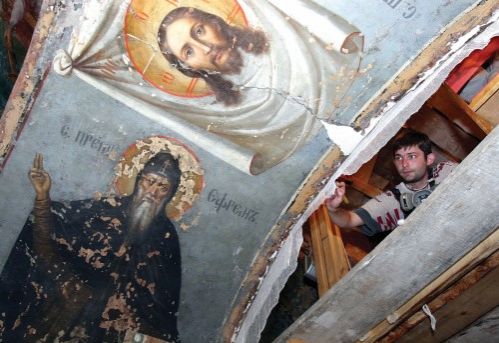Unique Polotsk cathedral receiving team of Union State restorers
Belarus’ oldest church — the Holy Transfiguration Church in Polotsk — is among the few having survived from Old Rus times, with its 12th century frescoes. Since 2007, Belarusians have been working jointly with the Russian Culture Ministry’s Inter-regional Scientific-Restoration Art Department to clean the frescoes. Meanwhile, this spring, archaeologists from St. Petersburg’s Hermitage joined in digging near the church walls.

Years required for masters to ‘open’ ancient frescoes layer by layer
The Belarusian Culture Ministry is keen to again attract architect-restorers to the ancient monument, establishing a joint Russian-Belarusian team of specialists (funded by the Union State) to preserve the unique church for future generations, notes Belarus’ Culture Minister, Boris Svetlov. The Archbishop of Polotsk and Glubokoe, Feodosy, has announced his support.
Russian specialists have visited the church, which was built during the time of St. Yevfrosiniya Polotskaya, gaining a full picture of the work to be undertaken. Sergey Lalazarov, a senior architectural restorer from St. Petersburg’s Spetsproektrestavratsiya Scientific-Research Institute, specialises in Old Russian architecture, having worked on St. Georgy’s Church in Staraya Ladoga (among the few remaining 12th century churches in Russia). As in Polotsk, its frescoes survived, although just 20 percent of the original number. The Polotsk site retains over 90 percent of its wonderful fresco artwork, much to Mr. Lalazarov’s excitement.
He explains that recent digs have significantly changed our views on the church’s initial appearance, saying, “Discovered fragments of galleries prove that we don’t know everything about the monument and our previous reconstructions of the facades were incorrect.”

Yelena Nikolaeva, a senior engineer-restorer and a member of the Russian Culture Ministry’s Federal Scientific-Methodic Council, has been working in the sphere of restoration since 1975. Impressed by Polotsk church’s strong walls, she notes, “Almost the entire construction has survived since the 12th century. It seems to me that the architects of the past had better construction materials than we have today!”
Speaking with these experts on Old Russian architecture, I realise that some are only seeing the unique church for the first time. Mikhail Milchik, the Deputy Chairman of the Cultural Heritage Preservation Department for the St. Petersburg Government, is among them. He tells me, “I’ve been studying Old Russian architecture since the 1960s and can say that Polotsk church enjoys global significance in terms of its preservation. We need to work on its inclusion on the UNESCO World Heritage List, as an example of restoration works. I support the Belarusian Culture Ministry’s proposal to create a specialist team and to address the Union State. This monument unites us.”
The Russians are proposing that the team should be headed by a specialist in 12th century sites, appreciating that preservation of the unique church is the priority, regardless of individual contribution by either side. The building was painted by Byzantine artists but is viewed as a shared treasure within our historical-cultural legacy.
Oleg Ioannisyan, the Head of the State Hermitage’s Architectural Archaeology Department and a permanent member of the Cultural Heritage Preservation Department for the St. Petersburg Government, is one of the oldest specialists to have researched Polotsk church, having visited in 1967, with famous Soviet archaeologist Pavel Rappoport, who supervised digs in Polotsk.
Mr. Ioannisyan tells us, “I felt culture shock on seeing the church, which is such a wonderful monument of our shared ancient civilisation. It would be more correct to call it Byzantium rather than Old Russian; not only Eastern Europe and the Balkans were under Byzantium’s influence but part of Asia. Byzantium influenced conceptions of beauty. I’m convinced that Polotsk should be visited by foreign specialists, who would find the church a revelation, making them see Belarus with new eyes.”
By Viktar Korbut











